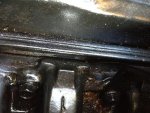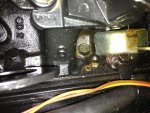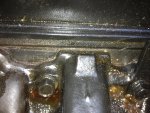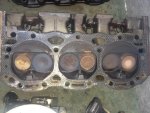'She?s been running rough on one engine' Is an understatement.
So, what happened, this boat (Sea Ray 260ov 1990) was purchased last year with known compression issues in the starboard engine, a test was carried out and all cylinders give 140 but number 6, which a gave a reading of 125psi after some oil.
The decision was taking to only inspect without opening up the motor, and at this time she ran sweetly on land. The engines were serviced and we splashed her.....all good, slow speed maneuvering absolutely fine, temps good, oil pressure good & engines sounding sweet. Suddenly we noticed a raw water cooling hose had burst....humm probably just old and brittle? We taped it up and continued. After powering up onto the plane, 10 minutes into our run the temp sender went crazy (I think it then dropped to 0). We immediately killed the starboard engine in gear at about 15 knots, and then took her out of gear.....then she started dieseling for about 20-30 seconds until we started her again to stop it. Opening the engine bay we discovered the starboard bank on the starboard engine had overheated, bubbling the exhaust tubing (we were running with a combination of corsas captains? choice on/off during the run). The manifold and header on that side were dangerously hot to touch so we limped back on one engine. Starting it back at the dock we heard a distinct 'huffing' noise coming from the motor.....it would tick over fine but there was something wrong.
After pulling the elbows and manifolds we found the elbows were junk (heavy corrosion from salt water) the manifolds were in good condition so I ran an acetone test and they did not leak. Both sides of the v6 looked similar.
This lead me to believe that we had an overheat due to a bad elbow, and when we killed the engine at speed with the corsa system active the wash from the aft of the boat forced some water back down the manifold and allowed the engine to diesel due to piston 6 &/or 4 having water intrusion. How wrong could I have been!
After replacing everything I am still getting the same symptoms, and that huffing noise was definitely not correct..... Water was found in 4&6, fresh water in 4 and caf? latte in 6, plug in 6 was destroyed beyond recognition with a cream coloured deposit over. Draining the oil showed a lovely caf? latte colour too. I flushed the cylinders out and ran two loads of diesel through the oil to clean out the mess. Strip down next. Intake manifold looks ok but has water mixed with oil under the carb, valve gear ok, but when the head came off I found cylinder 6 had a hole straight through the middle where the spark plug sparks. There is a rough surface all over the top of the head and valves, the same on the piston; see the pictures attached. It seems there has been a gasket breach between 4&6, but I can't work out where the water came from.
So, my first question, how do I determine the chain of events to work out what triggered this mess so I can address that?
One idea I have come up with is that cylinder 6 was running lean and/or timing was out causing detonation (thus the hole in the piston). But I don't know if this explains the low compression before the hole appeared (which I am sure was during the high speed run).
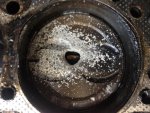

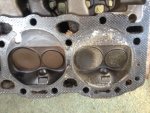
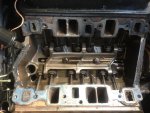
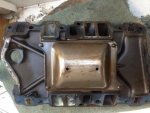
So, what happened, this boat (Sea Ray 260ov 1990) was purchased last year with known compression issues in the starboard engine, a test was carried out and all cylinders give 140 but number 6, which a gave a reading of 125psi after some oil.
The decision was taking to only inspect without opening up the motor, and at this time she ran sweetly on land. The engines were serviced and we splashed her.....all good, slow speed maneuvering absolutely fine, temps good, oil pressure good & engines sounding sweet. Suddenly we noticed a raw water cooling hose had burst....humm probably just old and brittle? We taped it up and continued. After powering up onto the plane, 10 minutes into our run the temp sender went crazy (I think it then dropped to 0). We immediately killed the starboard engine in gear at about 15 knots, and then took her out of gear.....then she started dieseling for about 20-30 seconds until we started her again to stop it. Opening the engine bay we discovered the starboard bank on the starboard engine had overheated, bubbling the exhaust tubing (we were running with a combination of corsas captains? choice on/off during the run). The manifold and header on that side were dangerously hot to touch so we limped back on one engine. Starting it back at the dock we heard a distinct 'huffing' noise coming from the motor.....it would tick over fine but there was something wrong.
After pulling the elbows and manifolds we found the elbows were junk (heavy corrosion from salt water) the manifolds were in good condition so I ran an acetone test and they did not leak. Both sides of the v6 looked similar.
This lead me to believe that we had an overheat due to a bad elbow, and when we killed the engine at speed with the corsa system active the wash from the aft of the boat forced some water back down the manifold and allowed the engine to diesel due to piston 6 &/or 4 having water intrusion. How wrong could I have been!
After replacing everything I am still getting the same symptoms, and that huffing noise was definitely not correct..... Water was found in 4&6, fresh water in 4 and caf? latte in 6, plug in 6 was destroyed beyond recognition with a cream coloured deposit over. Draining the oil showed a lovely caf? latte colour too. I flushed the cylinders out and ran two loads of diesel through the oil to clean out the mess. Strip down next. Intake manifold looks ok but has water mixed with oil under the carb, valve gear ok, but when the head came off I found cylinder 6 had a hole straight through the middle where the spark plug sparks. There is a rough surface all over the top of the head and valves, the same on the piston; see the pictures attached. It seems there has been a gasket breach between 4&6, but I can't work out where the water came from.
So, my first question, how do I determine the chain of events to work out what triggered this mess so I can address that?
One idea I have come up with is that cylinder 6 was running lean and/or timing was out causing detonation (thus the hole in the piston). But I don't know if this explains the low compression before the hole appeared (which I am sure was during the high speed run).

























